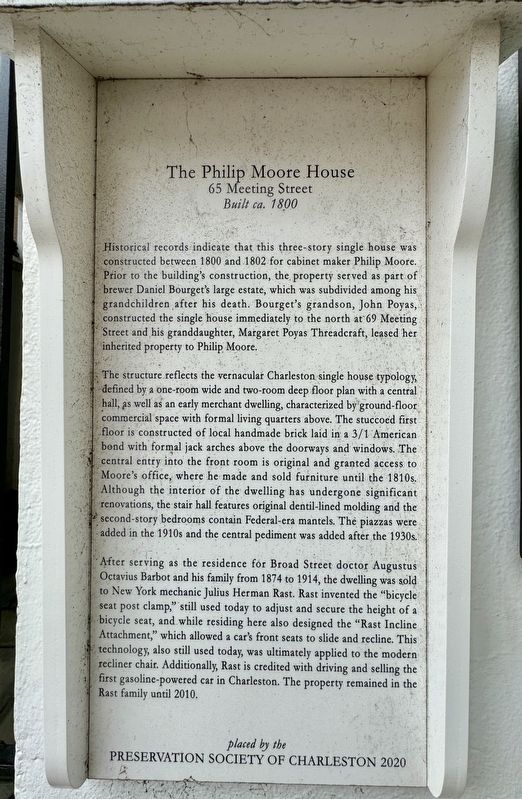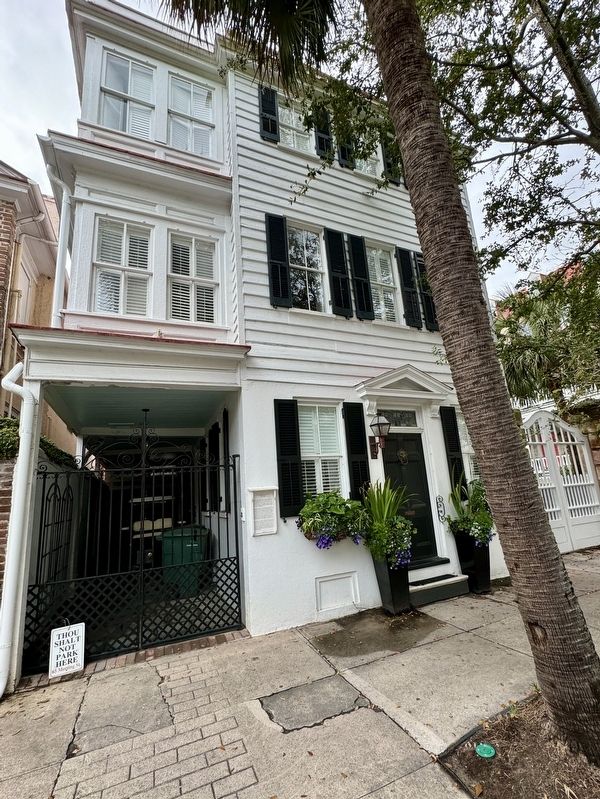Charleston in Charleston County, South Carolina — The American South (South Atlantic)
The Philip Moore House
65 Meeting Street
— Built ca. 1800 —
The structure reflects the vernacular Charleston single house typology, defined by a one-room wide and two-room deep floor plan with a central hall, as well as an early merchant dwelling, characterized by ground-floor commercial space with formal living quarters above. The stuccoed first floor is constructed of local handmade brick laid in a 3/1 American bond with formal jack arches above the doorways and windows. The central entry into the front room is original and granted access to Moore's office, where he made and sold furniture until the 1810s. Although the interior of the dwelling has undergone significant renovations, the stair hall features original dentil-lined molding and the second-story bedrooms contain Federal-era mantels. The piazzas were added in the 1910s and the central pediment was added after the 1930s.
After serving as the residence for Broad Street doctor Augustus Octavius Barbot and his family from 1874 to 1914, the dwelling was sold to New York mechanic Julius Herman Rast. Rast invented the "bicycle seat post clamp," still used today to adjust and secure the height of a bicycle seat, and while residing here also designed the "Rast Incline Attachment," which allowed a car's front seats to slide and recline. This technology, also still used today, was ultimately applied to the modern recliner chair. Additionally, Rast is credited with driving and selling the first gasoline-powered car in Charleston. The property remained in the Rast family until 2010.
Erected 2020 by Preservation Society of Charleston.
Topics. This historical marker is listed in this topic list: Notable Buildings. A significant historical year for this entry is 1800.
Location. 32° 46.517′ N, 79° 55.859′ W. Marker is in Charleston, South Carolina, in Charleston County. Marker is on Meeting Street north of Tradd Street, on the right when traveling south. Touch for map. Marker is at or near this postal address: 65 Meeting Street, Charleston SC 29401, United States of America. Touch for directions.
Other nearby markers. At least 8 other markers are within walking distance of this marker. John Cordes Prioleau House (a few steps from this marker); Constitutional Convention of 1868 (a few steps from this marker); Poyas-Mordecai House (within shouting distance of this marker); The South Carolina Society (within shouting distance of this marker); Ernest F. "Fritz" Hollings (within shouting distance of this marker); Sol Blatt, Jr. (within shouting distance of this marker); Judge J. Waties Waring (within shouting distance of this marker); James Francis Byrnes (within shouting distance of this marker). Touch for a list and map of all markers in Charleston.
Also see . . . Preservation Society of Charleston. (Submitted on March 7, 2024, by Brandon D Cross of Flagler Beach, Florida.)
Credits. This page was last revised on March 8, 2024. It was originally submitted on March 7, 2024, by Brandon D Cross of Flagler Beach, Florida. This page has been viewed 49 times since then. Photos: 1, 2. submitted on March 7, 2024, by Brandon D Cross of Flagler Beach, Florida. • Bernard Fisher was the editor who published this page.

